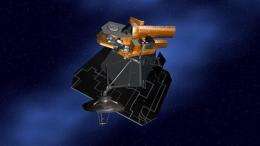NASA spacecraft set to rendezvous with comet

Five years after a NASA spacecraft bombarded a comet, it will visit another one Thursday. This time, there won't be celestial fireworks.
Speeding at 27,000 miles per hour, the Deep Impact craft instead will swing by a small comet, passing within 435 miles.
During the rendezvous, it will snap pictures of comet Hartley 2 as it races by, marking only the fifth time that a comet's core has been viewed up close.
Scientists hope the flyby will help them better understand how comets differ. Comets are icy bodies left over from the formation of the solar system some 4.5 billion years ago. Studying them could provide clues to how Earth and the planets formed and evolved.
"We're going to see pictures of a world we've never seen before - plain and simple," said mission scientist Jessica Sunshine of the University of Maryland.
The encounter is actually an encore mission for Deep Impact. It set off cosmic fireworks on July 4, 2005, when it fired a copper probe that crashed into comet Tempel 1. The high-speed collision spewed a cloud of debris into space, giving scientists their first peek of the interior.
After the $333 million comet-buster, NASA recycled Deep Impact for a new mission to visit another comet. It was supposed to target comet Boethin in 2008, but it was nowhere to be found. Scientists theorized the comet may have broken up into small pieces.
Deep Impact was then redirected to Hartley 2. Roughly three-quarters of a mile wide, Hartley 2 is the smallest comet to be photographed up close. On its way there, the craft spent several months scanning a cluster of nearby stars with known planets circling them.
While its latest task lacks the Hollywood drama, researchers still consider it an important mission.
"There are a lot of open questions about comets and their life cycle," said project manager Tim Larson of the NASA Jet Propulsion Laboratory, which manages the $42 million encore mission. "We have so little data that every time we have an opportunity to go near a comet, it's a chance to expand our knowledge."
Since September, Deep Impact has been stalking Hartley 2 like a paparazzo, taking images every 5 minutes and gathering data. Already, scientists have learned that the comet is quite spunky, releasing more gas outbursts than some of its bigger counterparts.
Hartley 2 passed within 11 million miles of Earth on Oct. 20 - the closest it has been to our planet since its discovery in 1986.
British-born astronomer Malcolm Hartley, who discovered the comet, said he never imagined a spacecraft would get so close to his namesake find.
"When I saw the comet, it was millions and millions of kilometers away," he said. "I'm extremely excited and feel very privileged. After all, I only discovered it."
More information:
Comet mission: http://epoxi.umd.edu/
Watch Live Coverage of EPOXI’s Hartley 2 Encounter on Nov. 4 www.nasa.gov/multimedia/nasatv/
©2010 The Associated Press. All rights reserved. This material may not be published, broadcast, rewritten or redistributed.





















